 W
WCatalan cuisine is the cuisine from Catalonia. It may also refer to the shared cuisine of Roussillon and Andorra, the second of which has a similar cuisine to that of the neighbouring Alt Urgell and Cerdanya comarques and which is often referred to as "Catalan mountain cuisine". It is considered a part of western Mediterranean cuisine.
 W
WAioli, allioli or aïoli is a sauce made of garlic, salt, and olive oil and found in the cuisines of the northwest Mediterranean, from Valencia to Calabria.
 W
WAlmadroc is a garlic-cheese sauce from medieval Catalan cuisine from the Llibre de Sent Soví. There is a similar recipe in the Llibre del Coch by Rupert de Nola for almadrote, a similar recipe for a sauce made with garlic, eggs, cheese and broth that was served with partridge. In modern usage it refers to an oil, garlic and cheese sauce served with eggplant casserole. Almadrote may have pre-Inquisition Sephardic origins and served with eggplant has become widespread in modern Turkish cuisine.
 W
WArròs negre is a Valencian and Catalan dish made with cuttlefish and rice, somewhat similar to seafood paella. Some call it paella negra, although it is traditionally not called a paella even though it is prepared in a similar manner.
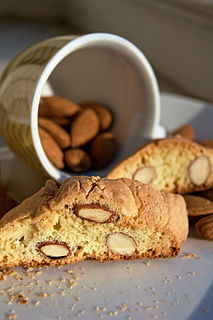 W
WBiscotti, known also as cantucci, are Italian almond biscuits that originated in the Tuscan city of Prato. They are twice-baked, oblong-shaped, dry, crunchy, and may be dipped in a drink, traditionally Vin Santo.
 W
WBotifarra is a type of sausage and one of the most important dishes of the Catalan cuisine.
 W
WBrandade is an emulsion of salt cod, olive oil, and usually potatoes. It is eaten in the winter with bread or potatoes. In French it is sometimes called brandade de morue and in Spanish it can be called brandada de bacalao. Brandade is a specialty of the Roussillon, Languedoc and Provence regions of Occitanie ; and Catalonia, Balearic Islands and Valencia in Eastern Spain. Similar preparations are found in other Mediterranean countries such as Italy, Portugal, the Greek Cyclades (brantada) and other regions of Spain where dried salt cod is also enjoyed.
 W
WBrossat, or brull in some zones, is a fresh cheese in Catalan cuisine made from whey (xerigot) resulting from the making of other cheeses, such as mató, a fresh or aged cheese, from sheep or goats.
 W
WCabello de ángel is a transparent threaded jam made from Siam pumpkin pulp and white sugar. It originated in Mallorca but its use has spread to the rest of Spain and some countries in the Americas.
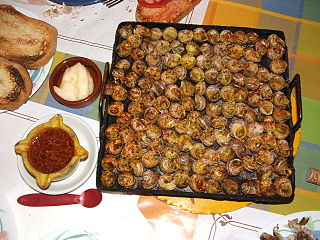 W
WCaragols a la llauna is a delicacy of Catalan cuisine. It is a simple plate for land snails cooked on a grill, or in a llauna in an oven. They are served with aioli or vinagrette. The dish is particularly favored in Terres de Lleida, where it has been promoted since 1980 by the Aplec del Caragol de Lleida, and in the Pyrenees. The same term is also used for a similar dish in Andorra.
 W
WBiscotti, known also as cantucci, are Italian almond biscuits that originated in the Tuscan city of Prato. They are twice-baked, oblong-shaped, dry, crunchy, and may be dipped in a drink, traditionally Vin Santo.
 W
WCatànies is a chocolate sweet typical of Vilafranca del Penedès and some other near towns made with marcona almonds. They are toasted and covered first by caramel and then by a thick layer of white chocolate or a mixture of almond, hazelnut and milk. Finally, they are covered by a thin layer of powdered black chocolate, sometimes mixed with a little bit of icing sugar. They are often offered as a gift or served alongside coffee after a meal.
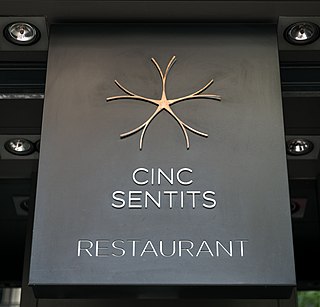 W
WCinc Sentits is a Michelin two-starred restaurant in Barcelona, Catalonia, Spain run by self-taught Chef-Owner Jordi Artal and Maitre-Owner Amèlia Artal. The restaurant's name comes from its goal of stimulating each of the five taste sensations.
 W
WThe coca is a pastry typically made and consumed in Catalonia, the Aragonese Strip, most of Valencia, the Balearic Islands, Andorra and in French Catalonia.
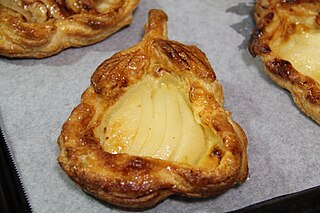 W
WA croustade is a French culinary term meaning a crust or pie-crust of any type. They are usually made of flaky pastry or puff pastry, but there are also bread croustades, potato croustades, rice, semolina and vermicelli croustades, among others.
 W
WEscalivada, also sometimes transcribed in Spanish as escalibada, is a traditional dish from Catalonia, Valencia, Murcia and Aragón of smoky grilled vegetables. It typically consists of roasted eggplant and bell peppers with olive oil and sometimes onion, tomato, minced garlic, and salt.
 W
WEscudella i carn d'olla, or shorter escudella, is a traditional Catalan meat and vegetable stew and soup. Francesc Eiximenis wrote in the 14th century that it was eaten every day by Catalan people.
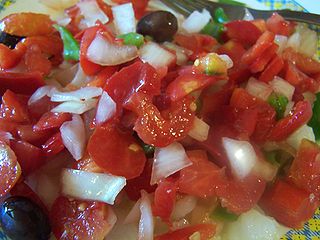 W
WEsqueixada is a traditional Catalan dish, a salad of shredded salt cod, tomatoes, onions, olive oil and vinegar, salt, and sometimes a garnish of olives or hard-boiled eggs. Specific recipes vary, with some including ingredients such as eggplant and bell peppers. Esqueixada is particularly popular in warm weather and is sometimes considered a summertime dish. It is often served as a tapas dish.
 W
WFuet is a Catalan thin, dry cured, sausage of pork meat in a pork gut. The most famous is made in the comarca (county) of Osona and is also known as Vic fuet.
 W
WGarrotxa is a traditional Catalan goat's milk cheese. Almost extinct by the early 1980s, it has been revived by a young cheesemakers and goat farmers' cooperative in the Garrotxa area of Catalonia. The revival began in 1981, and the cheese has since become widespread in artisanal production.
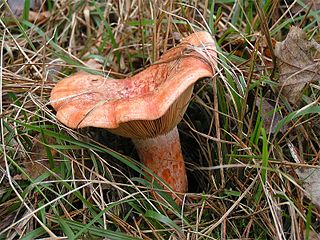 W
WLactarius deliciosus, commonly known as the saffron milk cap and red pine mushroom, is one of the best known members of the large milk-cap genus Lactarius in the order Russulales. It is found in Europe and has been accidentally introduced to other countries under conifers and can be found growing in pine plantations. A fresco in the Roman town of Herculaneum appears to depict Lactarius deliciosus and is one of the earliest pieces of art to illustrate a fungus.
 W
WLobster stew is found in a variety of cuisines. Two famous versions are Menorcan caldera de llagosta and Maine lobster stew.
 W
WMasia was a short-lived Spanish and Catalan restaurant in Portland, Oregon. Housed in the Hyatt Centric Downtown Portland, the restaurant was owned by married chefs José Chesa and Cristina Baez and their business partner Emily Metivier. Shortly after opening with breakfast, lunch, and dinner service in February 2020, the COVID-19 pandemic forced Masia to close temporarily. The restaurant operated in various forms throughout the remainder of 2020, offering take-out service and special pre-packaged dinners for select holidays. Owners initially planned to close temporarily in January 2021, but confirmed the restaurant's permanent closure in March.
 W
WMató is a fresh cheese of Catalonia made from cows' or goats' milk, with no salt added.
 W
WNeula is a type of Catalan biscuit, eaten traditionally in Christmas with cava and torró. They are often dipped into cava. It consist of a very thin sheet of a mixture of egg whites, butter, sugar and flour, flavoured with lemon and rolled. At present there are some other popular versions, as neules stuffed with torró de Xixona or others covered with a chocolate lay. At present, although they are typical on Christmas, they can sometimes be eaten during the rest of the year, for example with crema catalana or ice creams.
 W
WPa amb tomàquet, or Pan con tomate in Spanish, is a traditional food of Catalan, Valencian, Aragonese, Balearic and Murcian cuisines in Spain. Pa amb tomàquet is considered a staple of Catalan cuisine and identity. While considered a signature toast dish in Catalonia, it is common in bars throughout the rest of Spain, where it is also known either as pan con tomate or as pan tumaca.
 W
WA palmier, pig's ear, palm heart, or elephant ear is a French pastry in a palm leaf shape or a butterfly shape, sometimes called palm leaves, cœur de France, French hearts, shoe-soles, or glasses that was invented in the beginning of the 20th century.
 W
WPanellets are the traditional dessert of the All Saints' Day, known as Castanyada, in Catalonia, Andorra, Ibiza and the Land of Valencia, with chestnuts and sweet potatoes. Panellets are often accompanied with a sweet wine, usually moscatell, mistela, vi de missa or vi ranci. Panellets are small cakes or cookies in different shapes, mostly round, made mainly of marzipan. The most popular are the panellets covered with pine nuts, consisting of the panellet basis (marzipan) rolled in pine nuts and varnished with egg. In Sevilla, in southern Spain, these cookies are known as empiñonados.
 W
WPastissets, also called casquetes, pastissets or flaons are stuffed fried pastries from Catalan cuisine. They can be filled with cabell d'àngel jam, sweet potato jam, or almonds, even with mató cheese and codonyat. They are typical of Terres de l'Ebre and in Valencian Community. In Mallorca, there is a very similar preparation called rubiol.
 W
WPicada is one of the characteristic sauces and culinary techniques essential to Spanish cuisine. The technique is typically found in the Spanish region of Catalonia and Valencia and subsequently Catalan cuisine and Valencian cuisine. It is not an autonomous sauce like mayonnaise or romesco, but it is added as a seasoning during the cooking of a recipe.
 W
WA porrón is a traditional glass wine pitcher, which holds 0.75 litres (25 US fl oz) typical of Spain, originating in Catalonia and eventually spreading to other parts of Spain. This invention allows everyone to drink from the same utensil without touching it with their lips. It fosters communal drinking accompanying food, though it does require some skill to ensure the wine enters one's mouth and to keep it from spilling onto clothing. Some might say it resembles a cross between a wine bottle and a watering can. The top of the bottle is narrow and can be sealed off with a cork. Stemming upwards from the bottom of the pitcher is a spout that gradually tapers off to a small opening. It is shaped such that the wine stored inside it will have minimal contact with the air, while being ready to be used at all times. Until the mid-twentieth century it was very common in homes, but the tradition is now slowly being lost. The idea originated as a replacement to bota bags. Porrons are most commonly filled with regular wines, either white or red, but are also used to drink cava, and a smaller version filled with a sweet, dessert wine is also common in Catalan restaurants. The lack of contact with the lips allows a group of people to share the same vessel without offending their sense of hygiene.
 W
WRomesco is a tomato-based sauce that originated from Valls, Tarragona, Catalonia. The fishermen in this area made this sauce to be eaten with fish. It is typically made from any mixture of roasted tomatoes and garlic, toasted almonds, pine nuts, and/or hazelnuts, olive or sunflower oil, and nyora peppers. Flour or ground stale bread may be used as a thickener or to provide texture.
 W
WThe rousquille or rosquille is a type of sweet-tasting biscuit particular to Catalonia, including the French region of Languedoc-Roussillon. It is a ring-shaped, soft and crumbly pastry often covered with a layer of sugar icing.
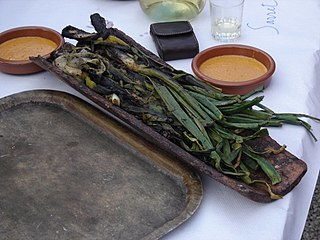 W
WSalvitxada or salsa de calçots is a Catalan sauce originating in Valls, in Tarragona, which is served almost exclusively with calçots at the calçotades, a traditional local barbecue.
 W
WSamfaina is a Catalan - Valencian dish based on diced eggplant and zucchini, a sofrito of chopped garlic and onion and grated tomato, cooked in olive oil. Other ingredients like red and green peppers can be added, as well as herbs like thyme and rosemary.
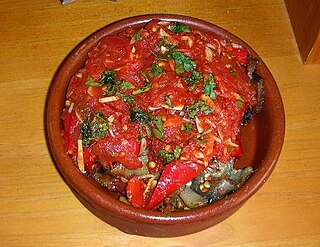 W
WTombet or tumbet is a traditional vegetable dish from Majorca, consisting of layers of sliced potatoes, aubergines and red bell peppers previously fried in olive oil. It is available at almost every local restaurant on the island.
 W
WA king cake, also known as a three king's cake, is a cake associated in many countries with Epiphany. Its form and ingredients are variable, but in most cases a fève such as a figurine, often said to represent the Christ Child, is hidden inside. After the cake is cut, whoever gets the fève wins a prize. Modern fèves can be made out of other materials, and can represent various objects and people.
 W
WTrinxat is a food from the Pyrenees, principally Andorra and the Catalan comarcas of Cerdanya and Alt Urgell. It is made with potatoes, cabbage and pork meat, and resembles bubble and squeak. The name, meaning “mashed” or “chopped”, is the past participle of the Catalan word trinxar, which means "to slice". It is sometimes served with salt herring or eaten on its own with bread.
 W
WTupí, also known as formatge de tupí, is a fermented cheese of a certain area of the Pyrenees and Pre-Pyrenees made from cows' or sheep's milk.
 W
WXató is a typical Catalan dish. It is a sauce made with almonds, hazelnuts, breadcrumbs, vinegar, garlic, olive oil, salt, and the nyora pepper. The sauce is often served with an endive salad prepared with anchovy, tuna and dried and salted cod (bacallà).
 W
WXuixo is a viennoiserie pastry from the city of Girona in Catalonia, Spain. It is a deep-fried, sugar-coated cylindrical pastry filled with crema catalana.